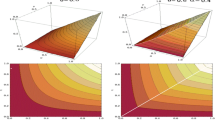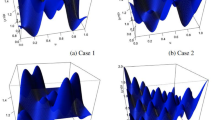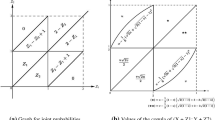Abstract
The Markov chain is well studied and widely applied in many areas. For some Markov chains, it is infeasible to obtain the explicit expressions of their corresponding finite-dimensional distributions and sometimes it is time-consuming for computation. In this paper, we propose an approximation method for Markov chains by applying the copula theory. For this purpose, we first discuss the checkerboard copula-based Markov chain, which is the Markov chain generated by the family of checkerboard copulas. This Markov chain has some appealing properties, such as self-similarity in copulas and having explicit forms of finite-dimensional distributions. Then we prove that each Markov chain can be approximated by a sequence of checkerboard copula-based Markov chains, and the error bounds of the approximate distributions are provided. Employing the checkerboard copula-based approximation method, we propose a sufficient condition for the geometric β-mixing of copula-based Markov chains. This condition allows copulas of Markov chains to be asymmetric. Finally, by applying the approximation method, analytical recurrence formulas are also derived for computing approximate distributions of both the first passage time and the occupation time of a Markov chain, and numerical results are listed to show the approximation errors.
Similar content being viewed by others
References
Abourashchi N, Veretennikov A. On exponential bounds for mixing and the rate of convergence for Student processes. Theory Probab Math Statist, 2010, 81: 1–13
Aït-Sahalia Y. Maximum likelihood estimation of discretely sampled diffusions: A closed-form approximation approach. Econometrica, 2002, 70: 223–262
Aït-Sahalia Y, Yu J. Saddlepoint approximations for continuous-time Markov processes. J Econometrics, 2006, 134: 507–551
Beare B K. Copulas and temporal dependence. Econometrica, 2010, 78: 395–410
Beare B K, Seo J. Time irreversible copula-based Markov models. Econom Theory, 2014, 30: 923–960
Bradley R C. Basic properties of strong mixing conditions. A survey and some open questions. Probab Surv, 2005, 2: 107–144
Chen X, Fan Y. Estimation of copula-based semiparametric time series models. J Econometrics, 2006, 130: 307–335
Chen X, Wu W B, Yi Y. Efficient estimation of copula-based semiparametric Markov models. Ann Statist, 2009, 37: 4214–4253
Cherubini U, Mulinacci S, Gobbi F, et al. Dynamic Copula Methods in Finance. New York: John Wiley & Sons, 2011
Clarkson J A, Adams C R. On definitions of bounded variation for functions of two variables. Trans Amer Math Soc, 1933, 35: 824–854
Darsow W F, Nguyen B, Olsen E T. Copulas and Markov processes. Illinois J Math, 1992, 36: 600–642
Duan J C, Dudley E, Gauthier G, et al. Pricing discretely monitored barrier options by a Markov chain. J Derivatives, 2003, 10: 9–31
Durante F, Kolesarova A, Mesiar R, et al. Semilinear copulas. Fuzzy Sets Systems, 2008, 159: 63–76
Durante F, Sempi C. Principles of Copula Theory. Boca Raton: Chapman & Hall/CRC, 2015
Durrett R. Probability: Theory and Examples, 4th ed. Cambridge: Cambridge University Press, 2010
Gobbi F, Mulinacci S. Mixing and moments properties of a non-stationary copula-based Markov process. Comm Statist Theory Methods, 2020, 49: 4559–4570
González-Barrios J M, Hoyos-Argüelles R. Estimating checkerboard approximations with sample d-copulas. Comm Statist Simulation Comput, 2021, in press
Hackbarth D, Miao J, Morellec E. Capital structure, credit risk, and macroeconomic conditions. J Financ Econ, 2006, 82: 519–550
Ibragimov R. Copula-based characterizations for higher order Markov processes. Econom Theory, 2009, 25: 819–846
Janssen P, Swanepoel J, Veraverbeke N. Large sample behavior of the Bernstein copula estimator. J Statist Plann Inference, 2012, 142: 1189–1197
Kolesarova A, Mesiar R, Kalicka J. On a new construction of 1-Lipschitz aggregation functions, quasi-copulas and copulas. Fuzzy Sets Systems, 2013, 226: 19–31
Kullback S, Leibler R A. On information and sufficiency. Ann Math Statistics, 1951, 22: 79–86
Lagerås A N. Copulas for Markovian dependence. Bernoulli, 2010, 16: 331–342
Li X, Mikusiński P, Sherwood H, et al. On approximation of copulas. In: Distributions with Given Marginals and Moment Problems. Dordrecht: Springer, 1997, 107–116
Liebscher E. Towards a unified approach for proving geometric ergodicity and mixing properties of nonlinear autoregressive processes. J Time Ser Anal, 2005, 26: 669–689
Loaiza-Maya R, Smith M S, Maneesoonthorn W. Time series copulas for heteroskedastic data. J Appl Econometrics, 2018, 33: 332–354
Longla M. On mixtures of copulas and mixing coefficients. J Multivariate Anal, 2015, 139: 259–265
Marshall A W, Olkin I, Arnold B C. Inequalities: Theory of Majorization and Its Applications. New York: Springer, 1979
Mesiar R, Komorníková M, Komorník J. Perturbation of bivariate copulas. Fuzzy Sets Systems, 2015, 268: 127–140
Meyn S P, Tweedie R L. Markov Chains and Stochastic Stability. New York: Springer, 1993
Mikusiński P, Taylor M D. Markov operators and n-copulas. Ann Polon Math, 2009, 96: 75–95
Mikusiński P, Taylor M D. Some approximations of n-copulas. Metrika, 2010, 72: 385–414
Nelsen R B. An Introduction to Copulas, 2nd ed. New York: Springer, 2006
Nummelin E. General Irreducible Markov Chains and Non-Negative Operators. Cambridge: Cambridge University Press, 2004
Olsen E T, Darsow W F, Nguyen B. Copulas and Markov operators. In: Distributions with Fixed Marginals and Related Topics. Lecture Notes Monograph Series, vol. 28. Bethesda: Inst Math Statist, 1996, 244–259
Ramsey J B, Rothman P. Time irreversibility and business cycle asymmetry. J Money Credit Bank, 1996, 28: 1–21
Réemillard B, Papageorgiou N, Soustra F. Copula-based semiparametric models for multivariate time series. J Multi-variate Anal, 2012, 110: 30–42
Rolski T, Schmidli H, Schmidt V, et al. Stochastic Processes for Insurance and Finance. Chichester: John Wiley & Sons, 1999
Sancetta A, Satchell S. The Bernstein copula and its applications to modeling and approximations of multivariate distributions. Econom Theory, 2004, 20: 535–562
Smith M, Min A, Almeida C, et al. Modeling longitudinal data using a pair-copula decomposition of serial dependence. J Amer Statist Assoc, 2010, 105: 1467–1479
Storesletten K, Telmer C I, Yaron A. Consumption and risk sharing over the life cycle. J Monetary Econom, 2004, 51: 609–633
Tucker H G. A generalization of the Glivenko-Cantelli theorem. Ann Math Statist, 1959, 30: 828–830
Vassiliou P-C. Fuzzy semi-Markov migration process in credit risk. Fuzzy Sets Systems, 2013, 223: 39–58
Yang J, Cheng S, Zhang L. Bivariate copula decomposition in terms of comonotonicity, countermonotonicity and independence. Insurance Math Econom, 2006, 39: 267–284
Zheng Y, Yang J, Huang J Z. Approximation of bivariate copulas by patched bivariate Fréechet copulas. Insurance Math Econom, 2011, 48: 246–256
Acknowledgements
The first and the third authors were supported by the National Key R&D Program of China (Grants No. 2018YFA0703900) and National Natural Science Foundation of China (Grants No. 11671021). The second author was supported by National Natural Science Foundation of China (Grants Nos. 11761051 and 11561047) and the Natural Science Foundation of Jiangxi Province (Grants Nos. 20181BAB211003 and 20192BAB211006). The authors thank two anonymous referees for their careful reading of the manuscript and helpful comments that led to an improved version.
Author information
Authors and Affiliations
Corresponding author
Rights and permissions
About this article
Cite this article
Zhou, Z., Xie, J. & Yang, J. A copula-based approximation to Markov chains. Sci. China Math. 65, 623–654 (2022). https://doi.org/10.1007/s11425-019-1687-2
Received:
Accepted:
Published:
Issue Date:
DOI: https://doi.org/10.1007/s11425-019-1687-2




